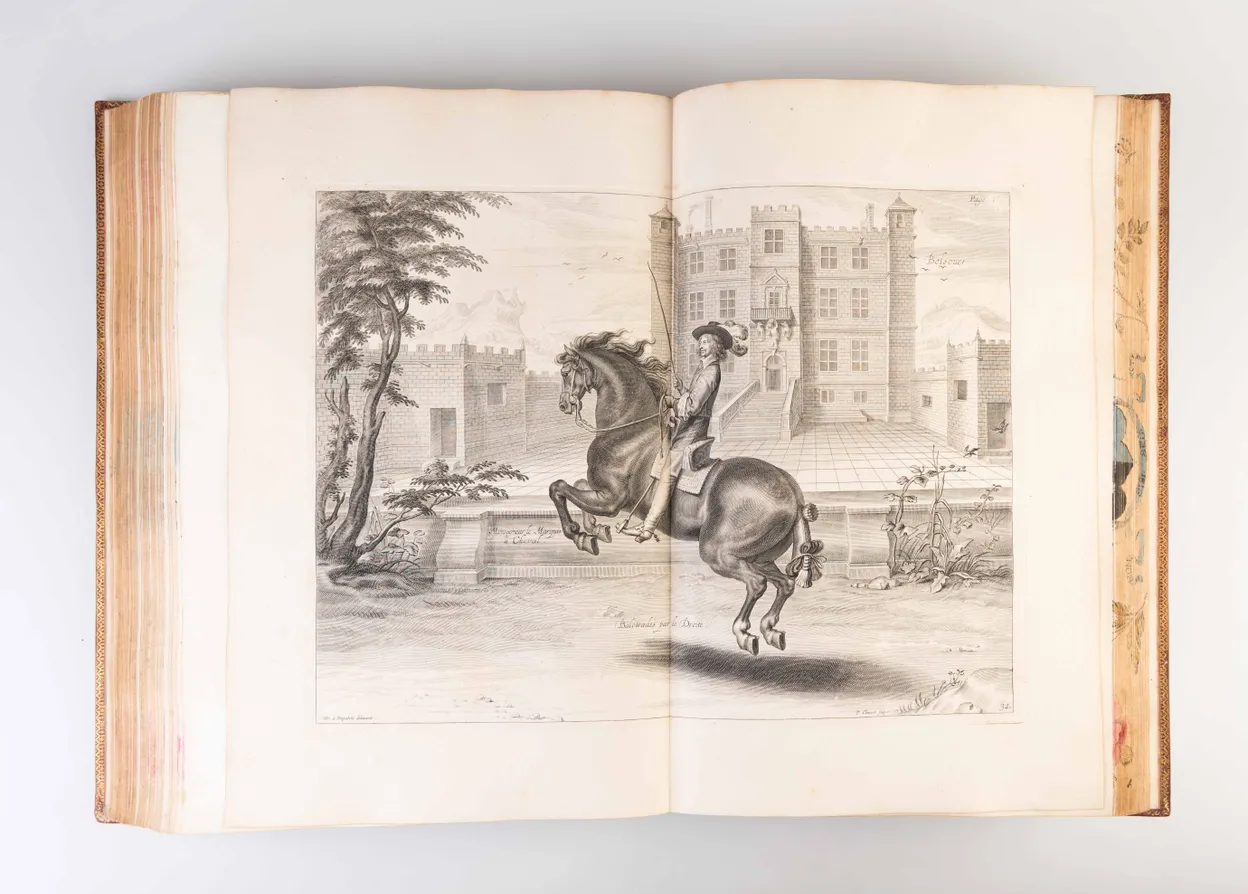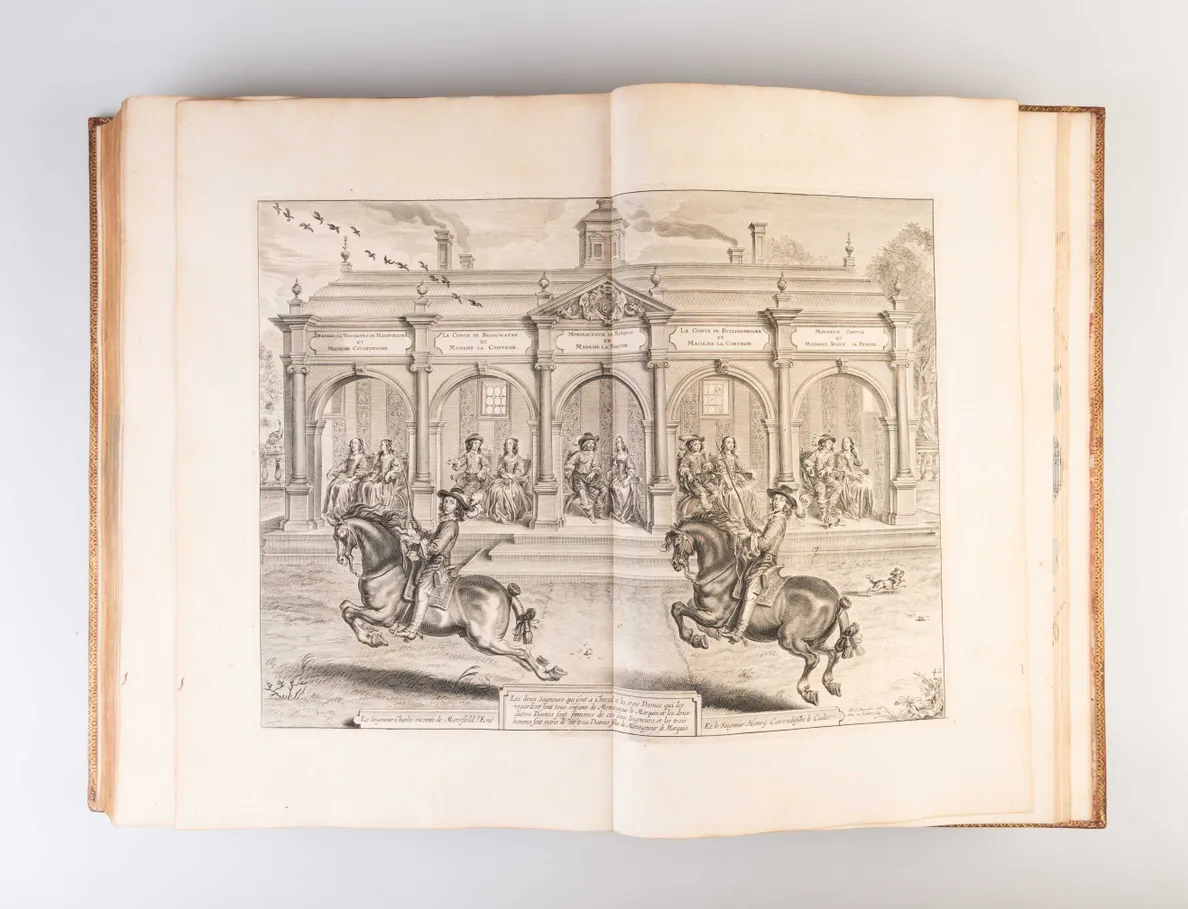First printed at Anvers in 1658 during Cavendish's self-imposed exile during the English Civil War, this second edition was printed on a better quality of paper using the same plates as for the first edition which had been acquired by the publisher John Brindley. The plates were used again by Brindley in 1743 for an English translation.
A remarkable copy of a monumental and lavishly illustrated work on horsemanship. Bound in elaborate English red morocco by the publisher of the work, John Brindley, bookseller by appointment to Queen Caroline and Frederick, Prince of Wales, for the physician, bibliophile and art collector Dr Richard Mead (1673-1754), physician to King George II, with the arms of Mead and his 2nd wife Anne, daughter of Sir Rowland Alston, painted under the gilt fore-edge.
Several other copies in similar bindings with bespoke armorial fore-edge paintings with the arms of Brindley's leading patrons are known. The British Library copy has a fore-edge painting with the arms of King George II (presented by Frank Benger in 1963/4). The copy in the Royal Library, Windsor castle, has a fore-edge painting with the arms of Queen Caroline, consort of King George II. A copy owned by the Earls of Derby bound in "contemporary red morocco gilt with flower-and-shell border enclosing a central lozenge made up of sunbursts, hunting horns and many other small tools" and with an unidentified armorial fore-edge painting of "a prancing horse and three stars to the sides" was sold at Christie's, 24/11/2009, lot 62, £18,750. A copy with a fore-edge painting of the arms of the Duke of Leeds was in Maggs Bros. Catalogue 548/1868 (1930), £21 (probably the same copy as the one with unidentified arms in Maggs Cat.460/2758 (1925), £25).
While in exile in Paris between 1645 and 1648 Cavendish, who had been created Marquess of Newcastle-upon-Tyne in 1643, bought a pair of Barbary horses which he took with him to Antwerp in 1648, where he established a riding-school and through loans of money managed to increase their number to eight. In these he found his chief "delight and pleasure", and in Methode et Invention he presented the results of his nine years of observations and trials. The manuscript was written in English and translated into French, and the cost of the work was above £1300. The text is interspersed with diagrams representing Cavendish training his horses, and the remarkable full-sheet plates engraved after drawings by the Dutch artist Abraham van Diepenbeke or Diepenbeeck (1596-1675) show him performing great feats of horsemanship, often set in front of fine views of Welbeck, Bolsover, or his other English houses. There are also allegorical designs in which he is shown being worshipped by his horses and amazing the gods of Olympus. Cavendish returned to England in 1660, and was restored to his offices and devastated estates and created Marquess in and then Duke of Newcastle-upon-Tyne in 1665.
This book was owned by (and specially bound for) Dr Richard Mead (1673-1754): "Mead's collection of books and manuscripts was second only to that of Hans Sloane. His books numbered some 10,000 volumes, including 146 incunabula and many fine bindings. His library was especially rich in the classics and in works of medicine and natural philosophy." (ODNB). The present volume appears as lot 402 sold on the 'Thirteenth Day's Sale' in the first sale on Monday, 2 December 1754 where it is described as 'C. M. C. T. F. D.', i.e. 'Charta Maxima' (large paper), 'Corio Turcico' (Turkey leather i.e. morocco) and 'Foliis Deauratis' (gilt edges).
Later Provenance: From the library of the Wentworth-Fitzwilliam family, Earls Fitzwilliam, with a 19th-century label of Milton Hall, Peterborough (the largest house in Cambridgeshire; their principal seat was Wentworth Woodhouse, the largest house in Yorkshire); by descent to George Charles Wentworth-Fitzwilliam (1866-1935), grandson of the 5th Earl Fitzwilliam, sale, Sotheby, 29/4/1918, lot 239 (the Mead arms then unidentified), £17 to J. & E. Bumpus. Maggs Bros., Catalogue 460/2758, 1925, £25. Pearson family, Viscounts Cowdray, of Cowdray Park, Sussex.




















